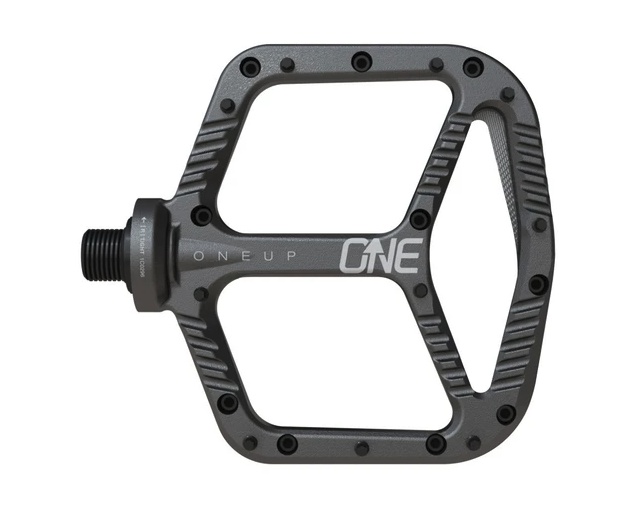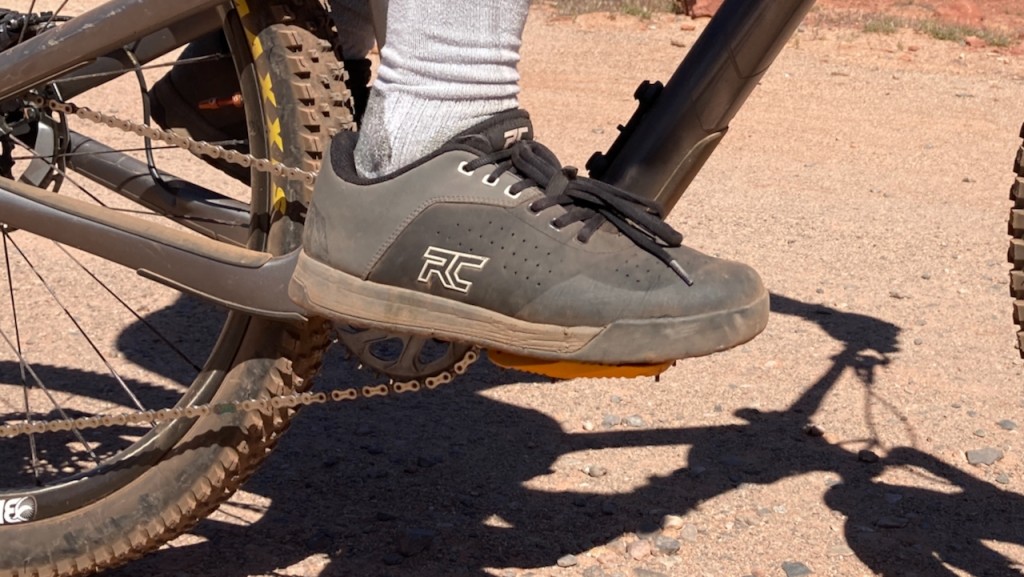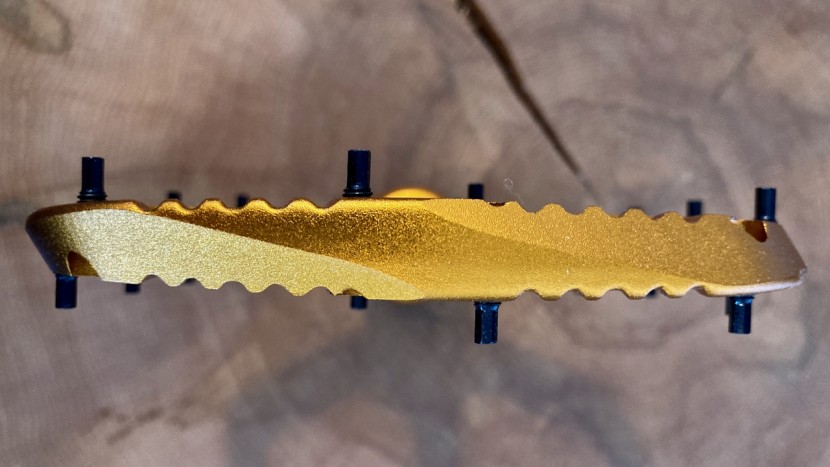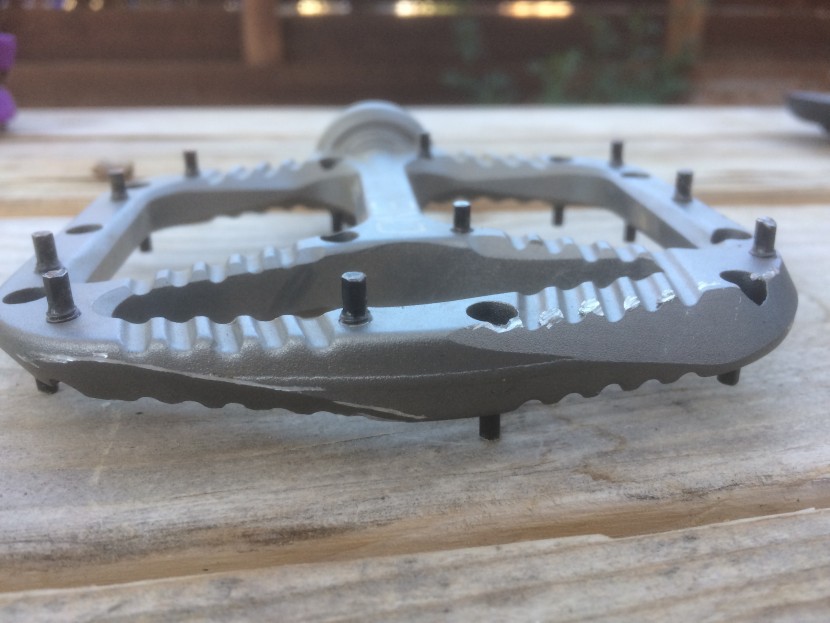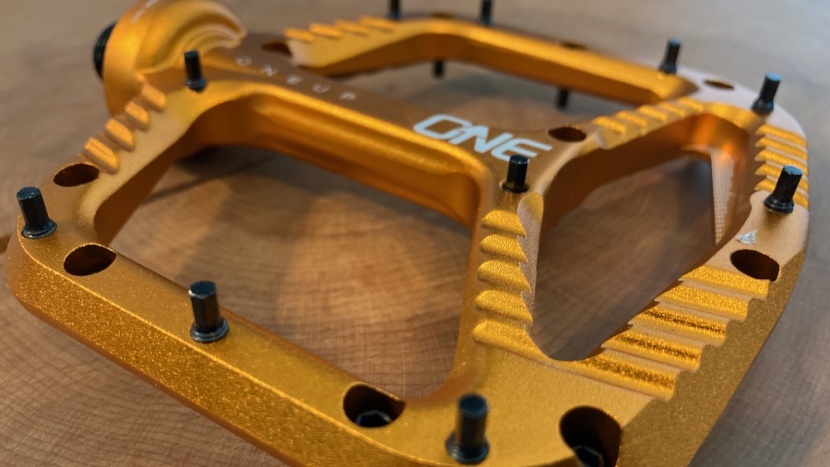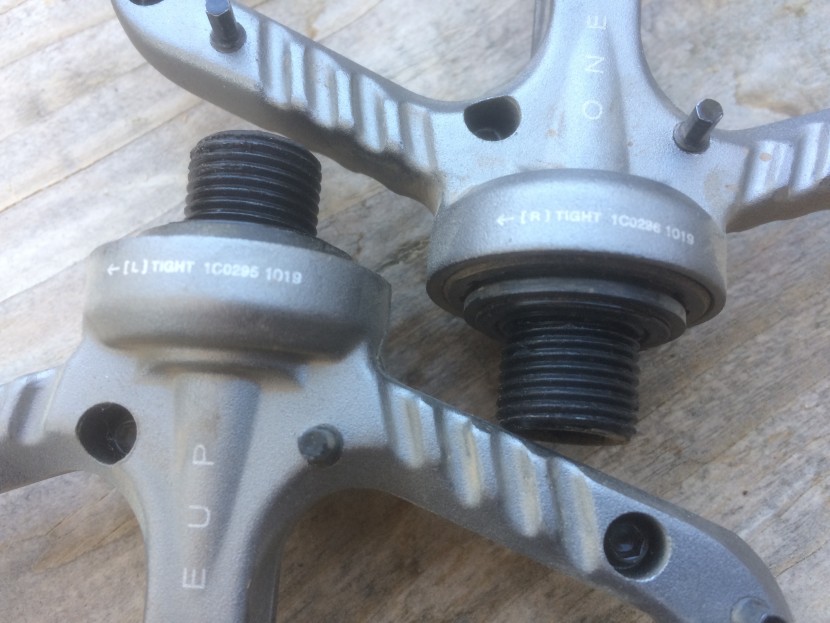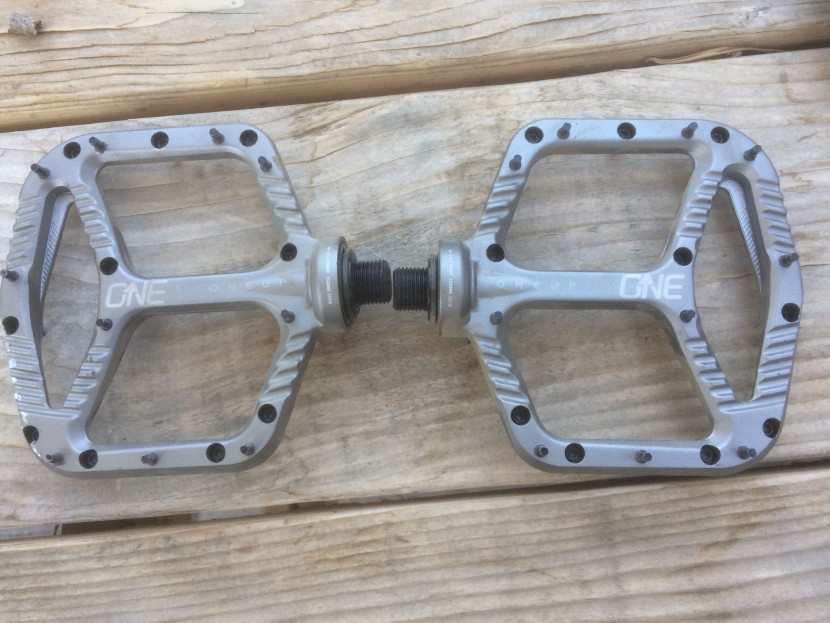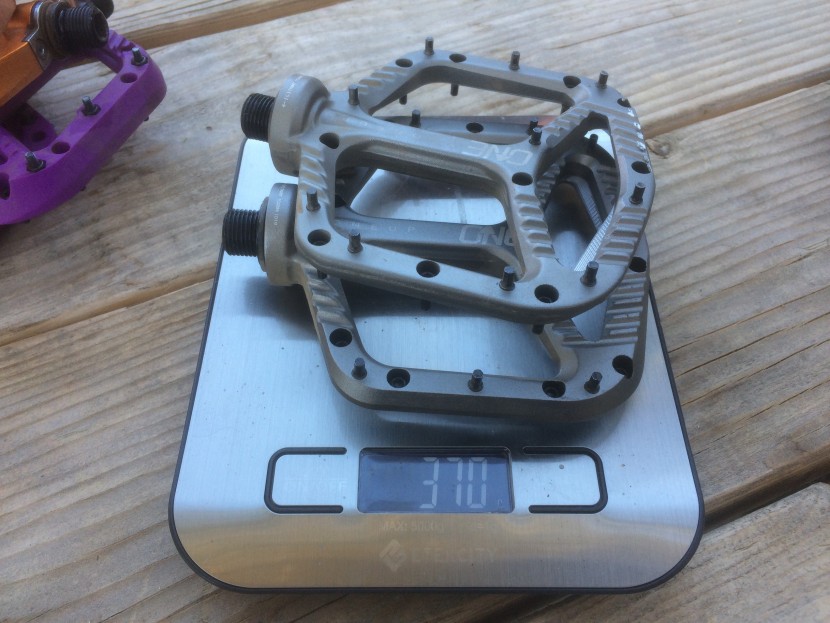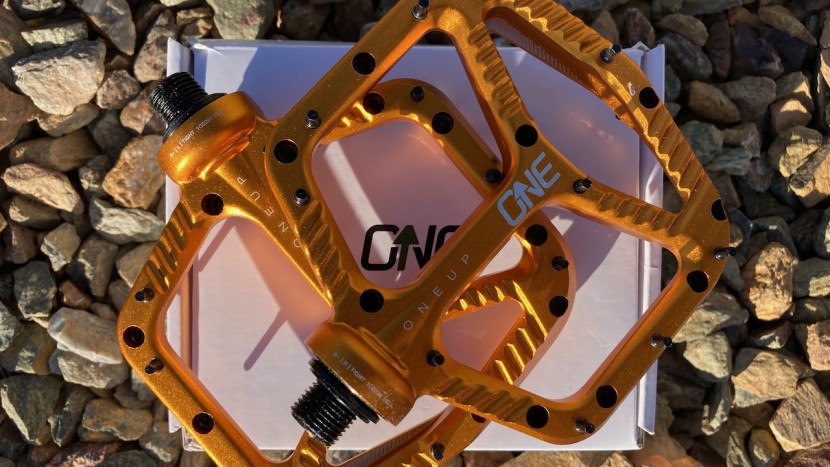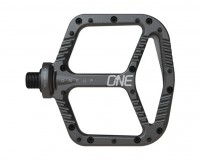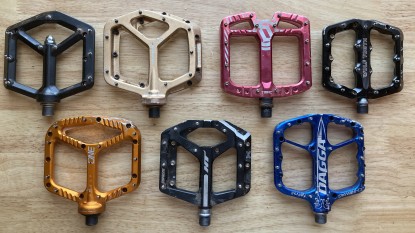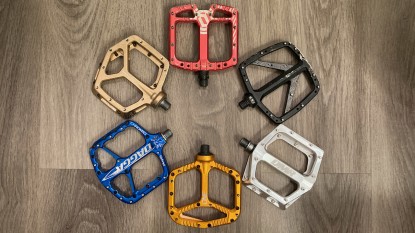OneUp Components Aluminum Review

Our Verdict
Our Analysis and Test Results
The OneUp Aluminum pedals are among the best all-around flat pedals we have ridden. They deliver a very well-rounded performance. Grip/traction are fantastic, and the platform has a great shape and a super-thin profile. Weight is reasonably low, and the pedals are straightforward to service, with replacement parts readily available.
Grip/Traction
The Aluminum pedals delivered fantastic levels of grip and traction. These pedals feature ten sizable traction pins. Our testers used these pedals with two different types of shoes, one wore Specialized 2FO shoes with SlipNot rubber, and the other wore the Bontrager Flatline with Vibram rubber. Both testers agreed that these pedals deliver an impressive but not overwhelming grip.
The ten bottom-loading traction pins are among the longest in our review, measuring approximately five millimeters in height. The pins are well-placed, with four at the front, three in the back, and three along the axle.
Textured ridges have also been machined into the pedal body in the open space between the pins. Riders can purchase a height adjustment spacer kit from OneUp to shorten all or some pins. The traction pins hooked up beautifully with our shoes, and even on the chunkiest and choppiest of downhills, our feet stayed in place. The OneUp pedals offer a secure hold so you can focus more on shredding and less on keeping your feet in the correct position.
One especially impressive area was climbing traction. We found these pedals to offer great grip while climbing in all situations. On technical pitches where you need to put some power into the pedals and use a lot of full-body movement, these pedals maintain an excellent grip on your soles.
Platform
The Aluminum pedals feature a large platform constructed of aluminum. The platform measures 114 mm x 104 mm. These large platforms are easy to find when placing your foot back on the cranks after drifting a corner or dabbing on a tricky section of trail.
The platform is generally symmetrical with a slightly chamfered/angled profile on the lead and front side edges. The platform is among the largest platforms of all the models we tested, and the 114 mm length provides plenty of support, even for people with larger feet. The 104 mm width is a nice middle ground that feels neither too narrow nor too wide and helps keep pedal strikes to a minimum.
The platform is 12.1 mm thick at the axle and 8.8 mm at the leading and trailing edges giving the pedal a slightly convex shape. It is typically a matter of personal preference, but concave pedals tend to be preferred by many riders. The reality is that when all of your weight is on your shoe, it tends to flex slightly, and a convex pedal shape matches that flex. Our testers did not take issue with the convexity of this pedal and, frankly, never noticed it on the trail. A large bearing and bulge are on the inboard side of the axle, which may be annoying for some riders, but it works well as a bumper to keep our feet from rubbing on our cranks.
The thin pedal profile is tremendously beneficial for many riders. The leading edge measures a scant 8.8 mm and the remainder 12.1 mm. While they may be only a few millimeters thinner than other pedals, this can be the difference between a bone-shaking pedal strike and lightly grazing a rock. We feel the thinner profile helps expand these pedals' versatility, making them a great option for everyone from trail to downhill riders.
The aluminum pedal body is both tough and durable. While less-expensive pedals often feature a composite (plastic) body, we prefer the tough and durable characteristics of an aluminum platform.
Mobility
Mobility was fine aboard the OneUp pedals. Due to the high levels of grip and traction, these are not the best pedals for those who like to adjust their feet frequently. Mobility can be important as you might drop a foot into a corner or put a foot down quickly at the top of a sketchy roll-in. Quickly getting your foot into the right position can be critical.
Simply put, the burly traction pins are not conducive to gently repositioning your foot. When your foot is weighted on this pedal, it isn't moving easily. With a quick bounce and unweighting, the foot can be adjusted, but it requires a very intentional movement.
The OneUp Aluminum did not lose many points in this metric because a spacer kit is readily available. This allows you to shorten the pins by adding a washer on the loading side of the pedal. If mobility is important, you can shorten some or all pins. These spacers can also be used to simulate concavity on the pedal by shortening the pins in the middle and keeping the front and rear pins long.
The pedal spins an appropriate amount on the axle. You can easily kick the platform and spin it slightly to get it in the correct position. If anything, they have a tiny bit of extra drag, which is better than the alternative. When a pedal spins too freely on the axle, it can accidentally spin too much if you pull your foot off the pedal leading to poor pedal positioning when it's time to put the foot back on.
Servicing
The OneUp Aluminum Pedals have a high-quality build and finish. The sleek and attractive appearance is paired with some critical details that OneUp nailed. For example, the pins load with a slightly larger three-millimeter allen key, making them harder to strip. It is the details that count. OneUp also includes four replacement pins with the pedals, and pin and bearing rebuild kits are reasonably priced and readily available.
The service procedure is impressive but does require a few more tools than some other pedals. Nevertheless, the process is straightforward, and OneUp has great instructions on its website. First, you must pull off a seal/washer pressed into the axle assembly. Next, a cassette lockring tool is used to pull off the retaining nut, which exposes the axle. You can then pull the axle out, thoroughly clean and grease it, and reassemble it. OneUp recommends servicing the axle and bearings every 50 hours. This is likely a little over the top, but it is only a 20-minute procedure. Should you need to rebuild your pedals fully, OneUp sells a bearing rebuild kit. OneUp also sells a pin kit for the Aluminum pedals, including 40 replacement pins and 40-0.8 mm height adjustment washers.
We want to mention that one of our testers used the OneUp Aluminum as their personal pedal. After about four months, the bearing on the right pedal seized and would no longer spin. The bearing nut could not be extracted as its threads were stripped. While this is a one-off incident, we feel it is worth mentioning.
Weight
The OneUp Components Aluminum Pedals hit the scale at 370-grams per set. Just holding them in your hand they feel lighter than other alloy pedals. On the bike, you may not notice the few additional grams over their lighter weight competitors, but you may notice the 60 plus grams lighter they are than the heaviest models we tested.
Value
We feel the Aluminum pedals are a great value. We were highly impressed with their on-trail performance. Additionally, these pedals are easily serviceable.
Conclusion
We love nearly everything about these pedals. The grip/traction is great, and your feet stay glued to the pedals on the chunkiest downhills. The platform is large yet quite thin and low-profile. These pedals are easy to service, and the manufacturer makes the instructions readily available and easy to follow. These pedals are a good choice for those seeking a versatile and well-rounded pedal.
| Awards | |
|---|---|
| Price | $150 List Check Evo (on sale!) |
Overall Score  |
|
| Star Rating | |
| Bottom Line | An all-around solid flat pedal that delivers good on-trail performance at a competitive price |
| Pros | A tremendous amount of grip, reasonable price tag, easy to service, versatile, large platform |
| Cons | Limited foot mobility, almost too much grip, convex shape may not be for everyone |
| Rating Categories | OneUp Components Alu... |
| Grip and Traction (25%) | |
| Platform (25%) | |
| Mobility (20%) | |
| Servicing (15%) | |
| Weight (15%) | |
| Specifications | OneUp Components Alu... |
| Measured Weight (per pair) | 370 g |
| Traction Pins (per side) | 10, 3 mm hex head bottom loading |
| Measured Platform Dimensions (millimeters) | 114 mm x 104 mm |
| Platform Profile (millimeters) - not including pins | 8.8 mm leading and trailing edges, 12.1 mm at axle |
| Concavity | slight convexity |
| Q Factor / Distance from cranks to furthest pin | 107.6 mm |
| Bearings | 4 double-sealed cartridge bearings |
| Body Material | Forged 6061-T6 aluminum |
| Pedal Wrench Type | 8 mm hex |


